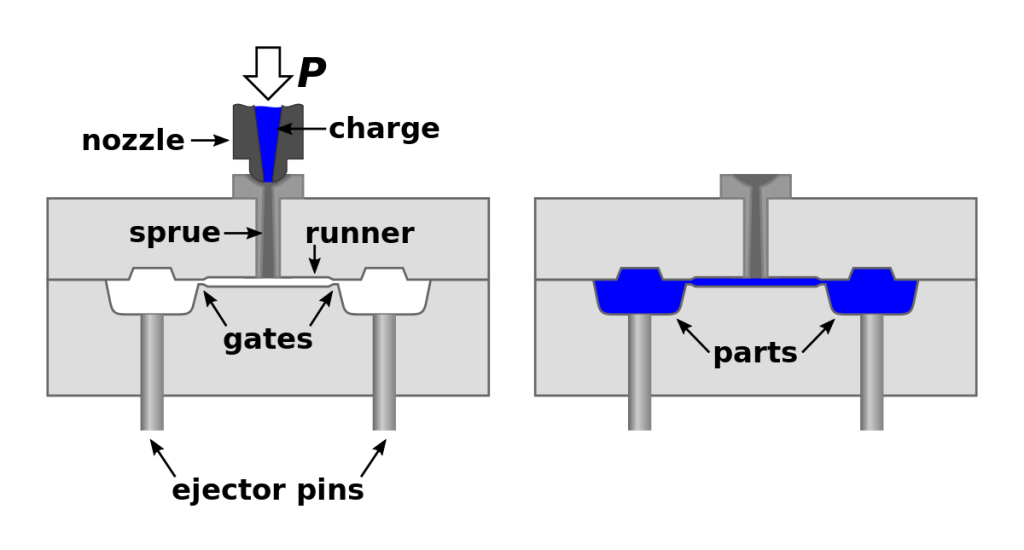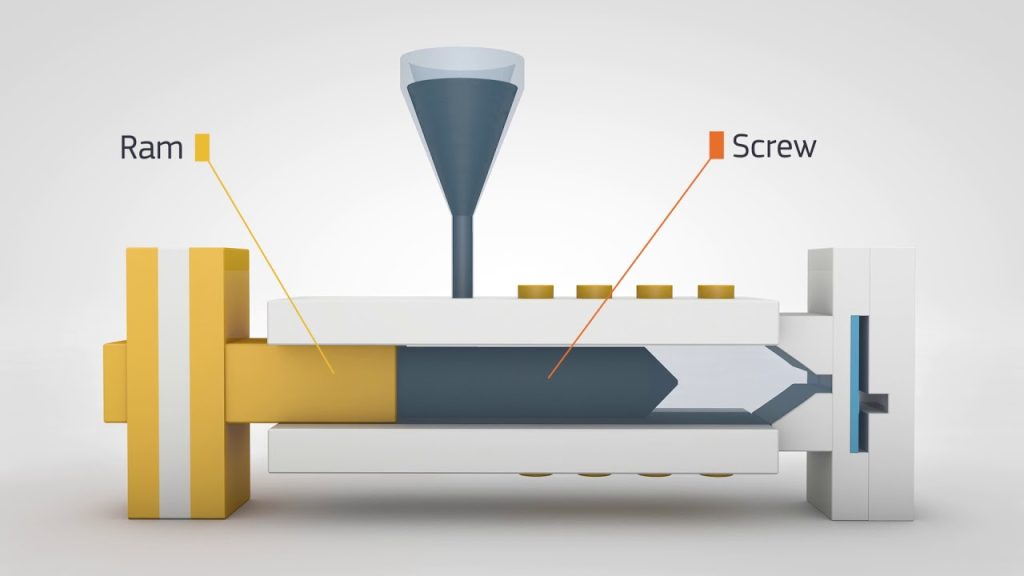Table of Contents
Have you ever wondered how plastic products are made? Two popular methods are extrusion and injection molding. While both techniques involve melting plastic and shaping it into a final product, there are significant differences between the two processes.
Extrusion involves melting plastic pellets and pushing them through a die to create a continuous shape, such as a tube or sheet. Injection molding, on the other hand, uses a mold to shape liquid plastic into a specific form. Understanding the differences between these two methods can help you determine which is best for your plastic manufacturing needs. Let’s take a closer look at the differences between extrusion and injection molding.
Extrusion and injection molding are two popular plastic manufacturing processes. Extrusion involves forcing melted plastic through a die, while injection molding involves injecting melted plastic into a mold. Extrusion is best for creating continuous shapes, such as pipes or tubing, while injection molding is ideal for producing complex shapes with high precision. Additionally, extrusion typically uses lower pressure and temperature than injection molding.
Understanding the Difference Between Extrusion and Injection Molding
What is Extrusion Molding?
Extrusion molding is a manufacturing process for creating long, continuous shapes with a constant cross-section. The process involves feeding raw plastic material into a heated barrel, which is then forced through a shaped die using a screw mechanism. The plastic is melted and then cooled, solidifying into a finished product. This process is typically used for creating products with a uniform cross-section, such as pipes, tubing, and hoses.
Extrusion molding has several advantages over other manufacturing processes. It is a relatively low-cost method of producing high volumes of products quickly and efficiently. Additionally, extruded products are typically lightweight, strong, and durable, making them ideal for a variety of applications.
Benefits of Extrusion Molding:
- Low cost production method
- High volume production capability
- Produces lightweight, strong, and durable products
What is Injection Molding?
Injection molding is a manufacturing process for creating complex, three-dimensional shapes from a range of materials, including plastics, metals, and glass. The process involves melting the material and injecting it into a mold, where it cools and solidifies into a finished product. Injection molding is commonly used for creating products with intricate shapes or designs, such as toys, automotive parts, and medical devices.
Injection molding has several advantages over other manufacturing processes. It is a highly precise method of production that can create complex shapes with a high degree of accuracy. Additionally, injection molding can be used to produce large quantities of products quickly and efficiently.
Benefits of Injection Molding:
- Highly precise method of production
- Can create complex shapes with a high degree of accuracy
- Can produce large quantities of products quickly and efficiently
Extrusion Molding vs. Injection Molding
While both extrusion molding and injection molding are manufacturing processes for creating plastic products, there are several key differences between the two methods.
One of the main differences is the shape of the finished product. Extrusion molding is typically used for creating products with a uniform cross-section, such as pipes, tubing, and hoses. Injection molding, on the other hand, is used for creating products with complex shapes or designs, such as toys, automotive parts, and medical devices.
Another difference is the cost of production. Extrusion molding is a relatively low-cost method of producing high volumes of products quickly and efficiently. Injection molding, however, can be more expensive due to the complexity of the process and the need for specialized equipment.
Extrusion Molding vs. Injection Molding: A Comparison
| Extrusion Molding | Injection Molding | |
|---|---|---|
| Shape of Finished Product | Uniform cross-section | Complex shapes and designs |
| Cost of Production | Relatively low-cost | Can be more expensive |
Which Method is Right for You?
The choice between extrusion molding and injection molding ultimately depends on the specific needs of your product. If you require a product with a uniform cross-section, such as a pipe or tubing, extrusion molding may be the best choice. If you require a product with a complex shape or design, such as a toy or medical device, injection molding may be the better option.
It is important to work with a qualified manufacturer who can help you determine the best manufacturing process for your product. By understanding the differences between extrusion molding and injection molding, you can make an informed decision that meets your specific needs and requirements.
Frequently Asked Questions
Here are some commonly asked questions about the difference between extrusion and injection molding.
What is extrusion molding?
Extrusion molding is a manufacturing process that involves forcing molten plastic material through a die to create a continuous profile. The die is a specially designed tool that shapes the plastic as it passes through, and the resulting profile can have a variety of shapes and sizes. Extrusion molding is often used for creating products with a consistent cross-sectional shape, such as pipes or tubing.
Extrusion molding is a relatively simple process that can be used to create large volumes of products quickly and efficiently. The process is also highly customizable, and can be adjusted to create complex profiles or to work with a variety of plastic materials.
What is injection molding?
Injection molding is a manufacturing process that involves injecting molten plastic material into a mold to create a solid part. The mold is a specially designed tool that creates the shape of the part, and the plastic is injected under high pressure to fill the mold completely. Injection molding is often used for creating complex, three-dimensional parts with intricate details and features.
Injection molding is a highly precise process that can produce parts with tight tolerances and excellent surface finishes. The process is also highly repeatable, making it ideal for large-scale production runs. However, injection molding tends to be more expensive than extrusion molding, and is generally better suited for smaller production runs or for creating highly specialized parts.
What are some key differences between extrusion and injection molding?
One of the key differences between extrusion and injection molding is the way that the plastic material is processed. In extrusion molding, the plastic is forced through a die to create a continuous profile, while in injection molding, the plastic is injected into a mold to create a solid part. Extrusion molding is generally better suited for creating products with a consistent cross-sectional shape, while injection molding is better suited for creating complex, three-dimensional parts with intricate details and features.
Another key difference between the two processes is their respective costs. Extrusion molding tends to be less expensive than injection molding, making it ideal for large-scale production runs of simple products. Injection molding, on the other hand, is generally more expensive but can produce highly precise and repeatable parts, making it ideal for smaller production runs or for creating highly specialized parts.
What are some advantages of extrusion molding?
One of the main advantages of extrusion molding is its ability to create large volumes of products quickly and efficiently. The process is highly customizable, and can be adjusted to create complex profiles or to work with a variety of plastic materials. Extrusion molding is also a relatively simple process, which means that it can be easily automated and requires minimal manual labor.
Additionally, extrusion molding tends to be less expensive than injection molding, making it ideal for creating simple products in large quantities. The process is also highly scalable, which means that it can be easily adapted to meet changing production needs.
What are some advantages of injection molding?
One of the main advantages of injection molding is its ability to produce highly precise and repeatable parts with tight tolerances and excellent surface finishes. The process is also highly customizable, and can be adjusted to create parts with complex geometries and features. Additionally, injection molding is highly automated, which means that it requires minimal manual labor and can be easily scaled up or down to meet changing production needs.
However, injection molding tends to be more expensive than extrusion molding, making it less suitable for large-scale production runs of simple products. The process is also more complex and requires more specialized equipment and expertise, which can make it more challenging to set up and maintain.
In conclusion, extrusion and injection molding are two of the most popular manufacturing processes used in the plastic industry. Although both methods involve the production of plastic products, they differ in their approach and application.
Extrusion molding is a continuous process that involves the heating and shaping of plastic materials into a desired shape, while injection molding is a cyclical process that involves injecting molten plastic into a mold cavity to form a specific shape.
The choice between extrusion and injection molding depends on the type of product being manufactured, the production volume required, and the desired level of precision and complexity. Ultimately, both methods have their unique advantages and disadvantages, and the decision on which to use will depend on the specific needs of the product and the manufacturing process.
Request a quote today!
[contact-form-7 id="1578" title="Contact form"]
Please compress the file into a ZIP or RAR file before uploading. Alternatively, send through your RFQ by email.
enquires@unitymanufacture.com

.png?ixlib=gatsbyFP&auto=compress%2Cformat&fit=max&rect=0%2C0%2C972%2C972&w=486&h=486)



